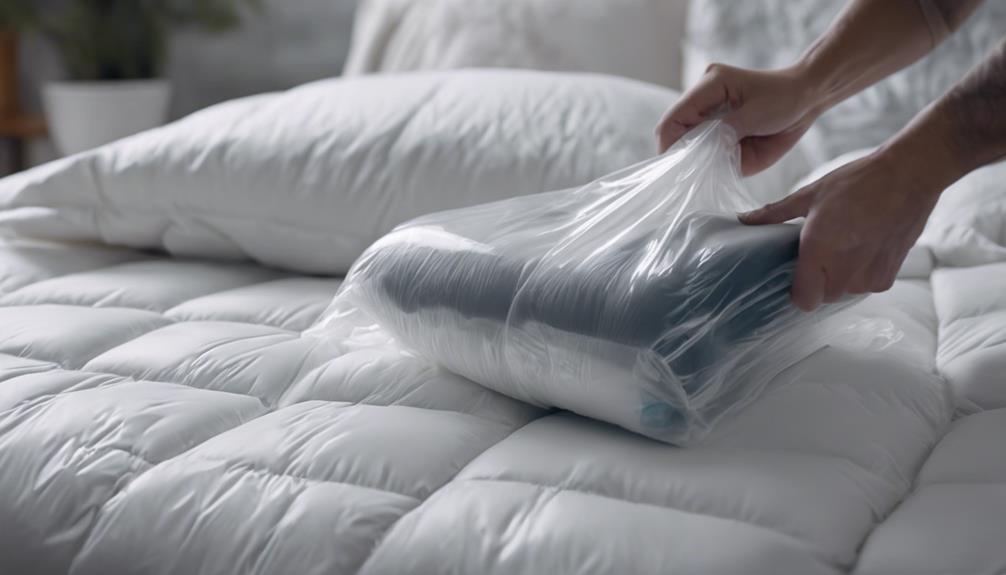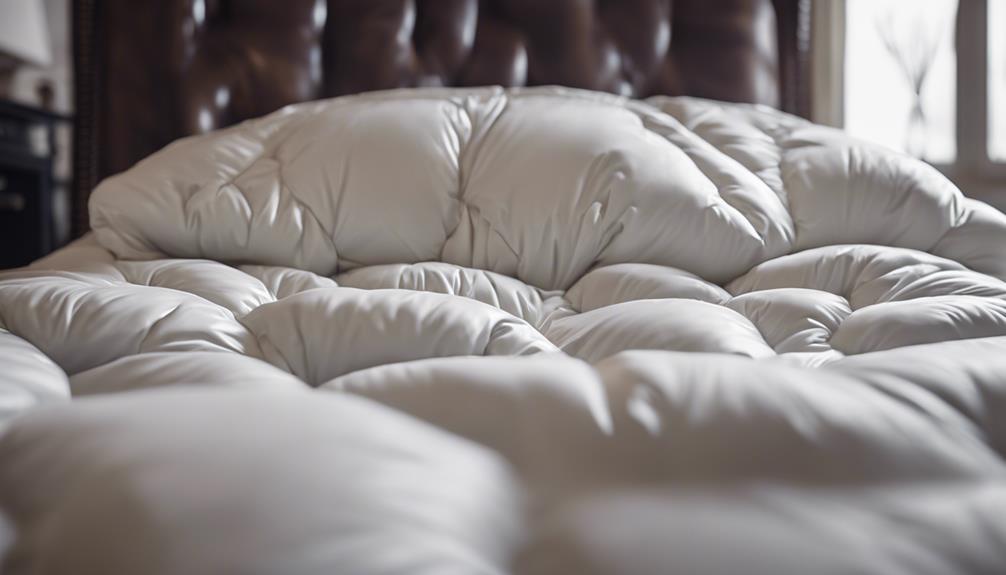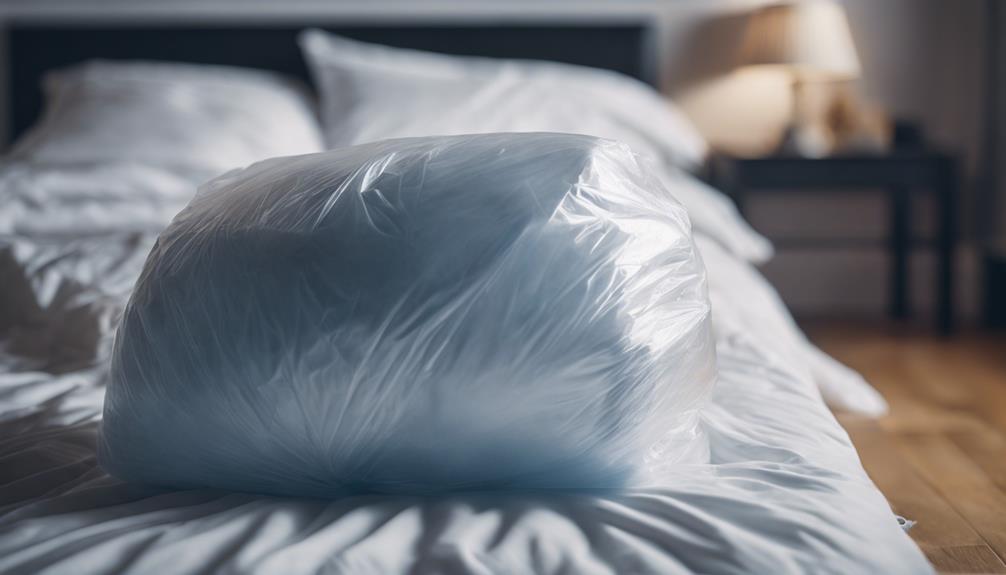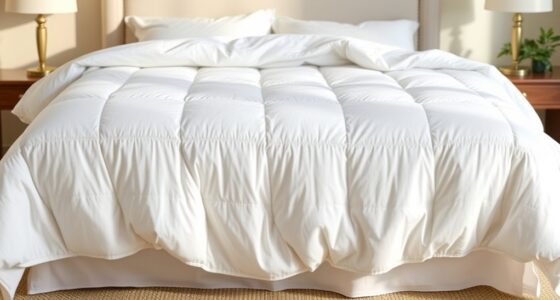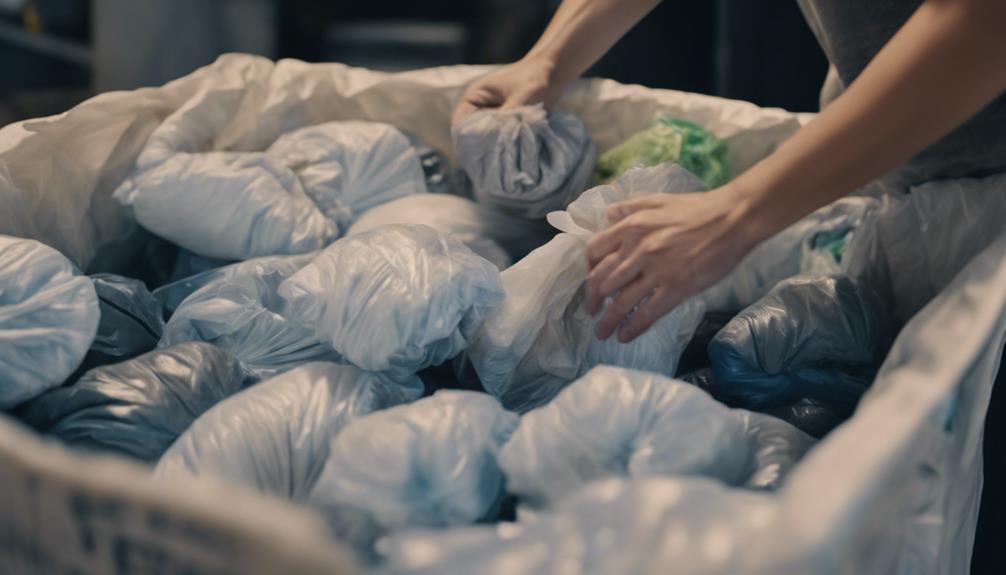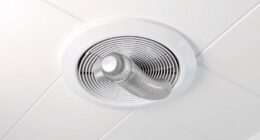Vacuum sealing a down comforter is not advised. It can compress delicate down fibers, reducing loft and insulation. This compression may cause moisture buildup, increasing the risk of mold growth. Consequently, vacuum sealing could harm the down comforter in the long run. If you are interested in learning more about proper storage options, alternatives to vacuum sealing, and tips for maintaining the fluffiness of your down comforter, feel free to continue exploring for detailed advice on preserving the quality and comfort of your bedding.
Key Takeaways
- Vacuum sealing may compress delicate down fibers, damaging the comforter.
- Compression can reduce loft and insulation properties of the down comforter.
- Moisture buildup is a risk with vacuum sealing, potentially leading to mold growth.
- Vacuum sealing is not recommended as it may compromise the quality and longevity of the comforter.
- To preserve the down comforter's fluffiness and insulation, avoid vacuum sealing and opt for breathable storage bags.
Why Vacuum Sealing Down Comforters Is Not Recommended
Vacuum sealing down comforters isn't recommended due to the important damage it can cause to the delicate down clusters, compromising their fluffiness and insulation properties.
When a down comforter is vacuum sealed in a plastic bag, the air inside the vacuum gets removed, leading to the compression of the down clusters. This compression can cause the down to clump together, affecting the comforter's ability to provide warmth effectively.
Since down comforters need air to maintain their loft and insulation properties, vacuum sealing can disrupt this essential air circulation, impacting the comforter's overall performance. The compression from vacuum sealing can also reduce the comforter's ability to trap heat, resulting in a potential loss of warmth.
To preserve the quality, lifespan, and comfort of your down comforter, it's advisable to avoid vacuum sealing and opt for proper storage methods that allow the comforter to breathe and maintain its fluffy insulation.
Effects of Vacuum Sealing on Down Comforters
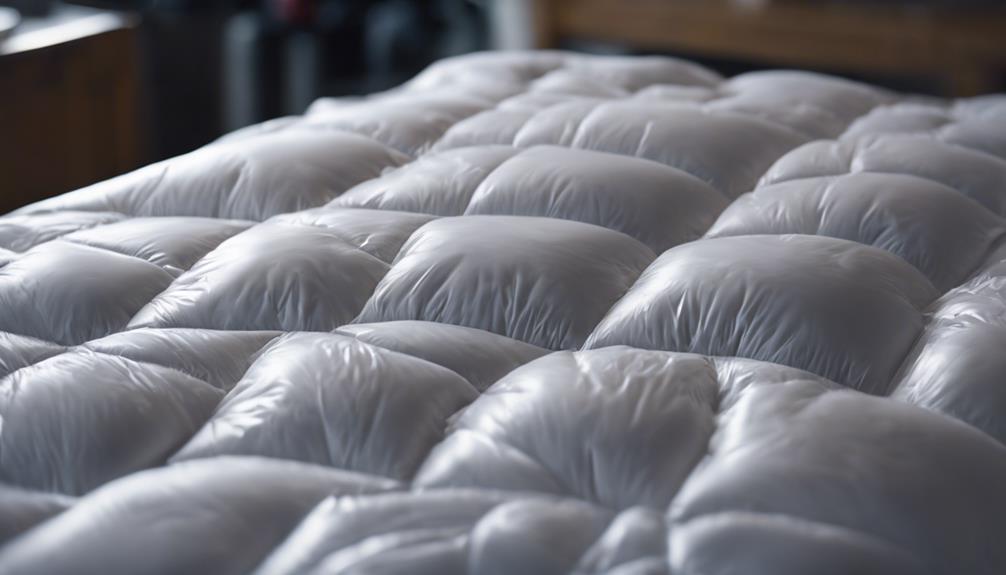
When storing a down comforter, it's important to take into account the potential effects of compression on its delicate down clusters.
Vacuum sealing a down comforter can have adverse effects on its quality. The compression from vacuum sealing can damage the down clusters, reducing their fluffiness and insulation properties. This can ultimately impact the comforter's ability to provide warmth.
Additionally, vacuum sealing may cause the down clusters to clump together, leading to an uneven distribution within the comforter. Over time, the repeated compression from vacuum sealing can diminish the loft of the down comforter, affecting its overall effectiveness and comfort.
Considering these factors, it's generally not recommended to vacuum seal down comforters, especially those filled with delicate down or feather duvets. To preserve the quality and longevity of your down comforter, alternative storage methods should be considered to maintain its fluffiness and insulation properties.
Alternatives to Vacuum Sealing Down Comforters
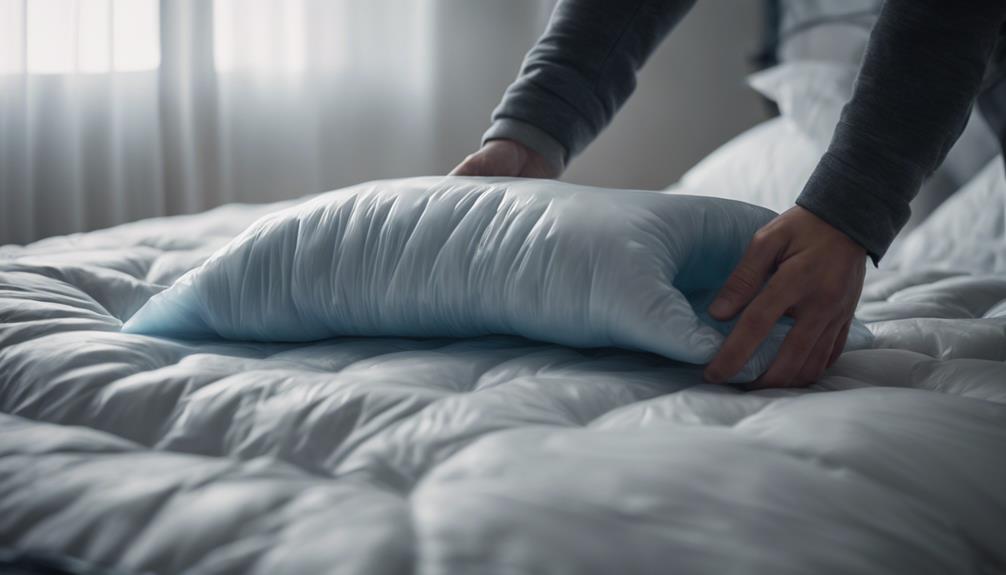
When it comes to finding alternatives to vacuum sealing down comforters, we can explore storage options like non-compressing bags. These bags are designed to maintain the fluffiness and integrity of down bedding without the need for compression.
Opting for compression bags specifically made for comforters can help preserve their quality and warmth.
Storage Options for Down Comforters
For preserving the fluffiness and effectiveness of down comforters, consider utilizing Neusu's non-compressing storage bags designed specifically for delicate bedding materials. These bags have a capacity of up to 200 Litres, making them suitable for storing multiple comforters.
Opting for non-compressing storage bags can help maintain the warmth and loftiness of the down filling, ensuring your comforter stays cozy and comfortable. Neusu's specialized storage solutions are tailored to protect delicate bedding materials, preventing damage and extending the lifespan of your down comforter.
- Non-compressing storage bags maintain fluffiness
- Capacity up to 200 Litres for multiple comforters
- Specialized storage solutions designed for delicate bedding
Compression Bags for Comforters
Compression bags provide a convenient and efficient alternative to vacuum sealing down comforters, guaranteeing proper storage without compromising the fluffiness and insulation properties of the delicate down clusters.
When using a storage bag designed for comforters, it's crucial to leave some air inside to prevent excessive compression. Neusu offers specialized duvet storage bags that allow for proper airflow, helping to maintain the loft and warmth of down comforters over time.
Proper Storage Options for Down Comforters
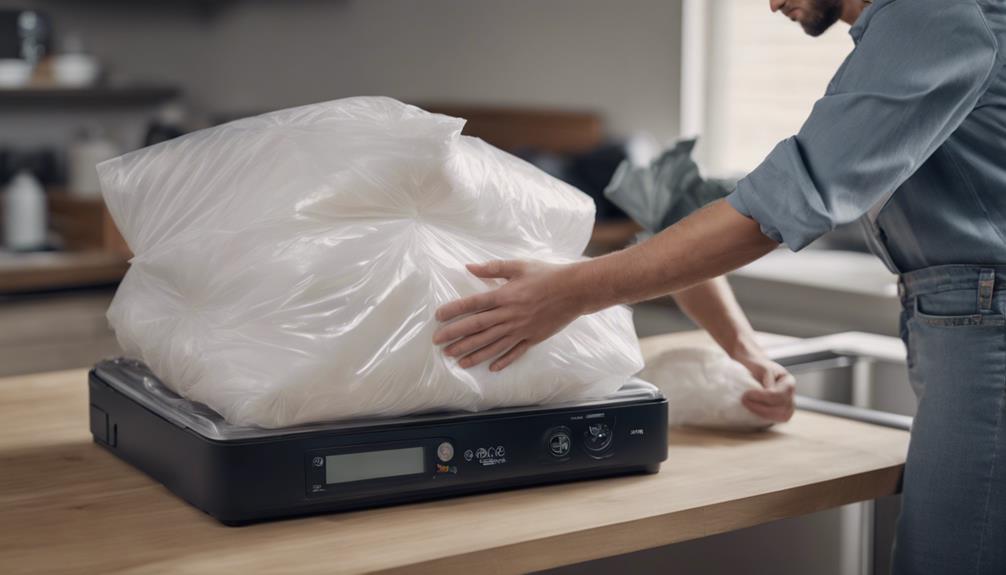
When considering proper storage options for down comforters, it's essential to opt for breathable storage bags or linen bags to shield the comforter from dust, bugs, and moisture. These bags are vital in maintaining the integrity of the delicate down clusters while stored.
Additionally, make sure the down comforter is stored in a cool, dry place to prevent mold and mildew growth and to safeguard its quality.
Storage Bag Recommendations
Using specialized non-compressing storage bags, such as those offered by Neusu, guarantees that down comforters can be stored effectively without risking damage to the delicate down filling. These bags are designed to maintain the fluffiness and warmth of the comforter while preventing compression.
When selecting a storage bag for your down comforter, make sure to take into account the size to guarantee a proper fit. Neusu offers a range of sizes, including bags with capacities up to 200 Litres, catering to different comforter sizes. Additionally, opt for bags made from breathable materials to prevent moisture buildup and mildew, preserving the quality of the down filling for longer periods.
- Choose the right size storage bag for a proper fit.
- Select breathable materials to prevent moisture buildup.
- Consider Neusu bags with capacities up to 200 Litres.
Closet Space Considerations
Considering the importance of maintaining the quality and longevity of down comforters, proper storage options in closets play a significant role in preserving their fluffiness and effectiveness.
To guarantee your down comforter stays in top condition, it's essential to follow care instructions and store it in a cool, dry spot. Avoid placing it on the ground or in humid areas to prevent damage and mold growth. Ideal storage locations include linen closets or armoires with sufficient ventilation to keep the comforter fresh.
Keep in mind that humidity can lead to mold and mildew, so selecting a dry storage spot is crucial. If using a vacuum bag, make sure to follow the manufacturer's guidelines to prevent compressing the down too much and affecting its loftiness inside the vacuum bag.
Tips for Preserving Down Comforter Fluffiness

To maintain the fluffiness of your down comforter, consider storing it in non-compressing storage bags or breathable linen bags. This helps to guarantee proper air circulation and prevents the delicate down feathers from being compressed, which can lead to a loss of loft and warmth.
Additionally, make sure your comforter is completely dry before storing it to prevent mold or mildew growth.
- Use non-compressing storage bags or breathable linen bags
- Guarantee the comforter is completely dry before storing
- Avoid vacuum sealing to prevent compression and damage to the down clusters
Common Mistakes When Storing Down Comforters

When storing down comforters, it's crucial to avoid the common mistake of vacuum sealing, which can harm the delicate down clusters and compromise their fluffiness. Over-compression from vacuum sealing can lead to clumping and loss of insulation in a down comforter. This can cause the down comforter to lose its loft and warmth over a period of time.
Additionally, using vacuum storage bags on down comforters can flatten the feathers, affecting their ability to provide warmth. To guarantee the longevity and quality of your down comforter, it's best to opt for non-compressing storage solutions next time. By avoiding vacuum sealing and choosing proper storage methods, you can help maintain the fluffiness and effectiveness of your down comforter for an extended period of time.
Best Practices for Long-Term Down Comforter Storage

For best preservation of a down comforter over an extended period, prioritize utilizing breathable storage bags or containers instead of vacuum sealing. When storing your down comforter for the long term, consider the following best practices:
- Avoid Compression: Opt for breathable storage options to prevent compressing the delicate down, ensuring it stays fluffy and maintains its insulation properties.
- Prevent Moisture Buildup: Store the comforter in a cool, dry place to avoid moisture accumulation, which can lead to mold growth and damage the down fibers.
- Regular Maintenance: Periodically inspect and fluff the down comforter during storage to retain its original loft and keep it warm and cozy when you bring it out again.
Following these guidelines will help you preserve the quality and comfort of your down comforter for many seasons to come.
Frequently Asked Questions
Can You Vacuum a Down Comforter?
Yes, vacuuming a down comforter isn't recommended. The delicate down clusters can be compressed, reducing fluffiness and warmth. This damage affects the comforter's insulation properties and can cause lumps and uneven distribution of down.
Opt for breathable storage like cotton bags to maintain the comforter's quality. Vacuum sealing can harm a down comforter, so it's best to avoid it for preserving its loft and softness.
What Is the Best Way to Store a Down Comforter?
When storing a down comforter, choose a breathable cotton bag to maintain its fluffiness. Keep it in a cool, dry spot to prevent mold. Avoid vacuum sealing since it can compress the feathers. Rolling the comforter prevents creasing and maintains loftiness.
Regularly check for dampness to prevent mold growth. These tips help preserve your down comforter for cozy nights ahead.
Is It Okay to Vacuum Seal a Puffer Jacket?
Yes, vacuum sealing a puffer jacket can damage its insulation, stitching, and fabric. Compressing the insulation reduces warmth and loft, while the fill may clump or lose shape. Moisture trapped inside can cause mold or mildew. It's not recommended as it compromises the jacket's performance and longevity.
For best storage, consider alternatives like hanging or folding in a breathable bag to maintain its quality.
How to Vacuum Seal a Comforter?
We don't recommend vacuum sealing a comforter as it can damage the delicate feathers and affect its fluffiness and warmth. It's better to store a comforter in a breathable bag or linen cover to maintain its quality.
Vacuum sealing may compromise the insulation properties of a comforter, making it lumpy. For gentle storage and to guarantee longevity, avoid vacuum sealing and opt for proper storage methods.
Can Vacuum Sealing a Down Comforter Damage It?
Vacuum sealing a down comforter can potentially damage the delicate feathers inside. The pressure from the vacuum can cause the feathers to become compressed, affecting the loft and warmth of the comforter. It’s best to use breathable storage bags specifically designed for vacuum seal down comforters to prevent any damage.
Conclusion
To sum up, vacuum sealing a down comforter isn't recommended as it can compress the feathers, leading to loss of fluffiness and insulation.
Instead, opt for breathable storage bags or containers to protect your comforter.
Remember, a squished comforter is like a deflated balloon at a party – no one wants that!
So, keep your down comforter fluffy and cozy by storing it properly and avoiding the vacuum seal.
